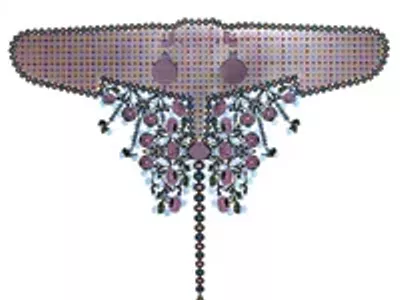
Audio By Carbonatix
[
{
"name": "GPT - Leaderboard - Inline - Content",
"component": "35519556",
"insertPoint": "5th",
"startingPoint": "3",
"requiredCountToDisplay": "3",
"maxInsertions": 100,
"adList": [
{
"adPreset": "LeaderboardInline"
}
]
}
]
Envision a neighborhood of single-family homes constructed entirely out of artfully arranged, recycled shipping containers. Yes, shipping containers. The ubiquitous sort we all drive by in the rail yard on West Vernor Highway in Southwest Detroit: piles of colorful steel boxes stacked up like oversized Legos.
Just such a project, conceptualized by local architect Steven C. Flum and his team, along with Leslie and Patrick Horn's San Diego development firm Brother and Sister Developers, is one of the innovative green housing projects featured in MOCAD's exhibit Considering Architecture: Sustainable Design by Detroit Architects.
Detroit needs exhibits that prompt civic discourse around sustainability. We have local architect Brian Hurttienne to thank for this one. The idea came together after visiting a similar show at the Museum of Contemporary Art in Chicago two years ago. He followed up with director Marsha Miro and deputy director Greg Tom at our own contemporary art museum.
Sponsored by the American Institute of Architects' Detroit Urban Priorities Committee, the Urban Land Institute, and the U.S. Green Building Council, Considering Architecture highlights "green" building and design by regional Detroit-based architects. Hurttienne identified projects by local architects that were either in the design process or already built, with a goal of providing the public with "a unique and valuable basis for education and practical application." Seven architectural projects, most located in Southeastern Michigan, are displayed and include housing, institutional buildings and one mixed-use district.
Although I hate to criticize, both the definition and context for the viewing public seem lacking. For instance, how do the curators' define "sustainability"? What does LEED stand for? Architects use these terms and assume that they are household words. Rossetti's "Metropolitan Gardens in Denver" is the only project that features panels explaining esoteric terms such as TOD (Transit Oriented Development — focusing density and investment along mass transit lines) and LEED ND (Leadership in Energy and Environmental Design — Neighborhood Design). Given the overall goal of education, these are essential bits of information that the public needs in order to understand and appreciate the projects and the growing "green" movement in architecture and urban design. This broad context should have led organizers to curate the show a bit differently.
Secondly, sustainability —whether social, economic or environmental — is an attempt to "meet the needs of the present without depleting resources or harming natural cycles for future generations," as well-put by an essayist for the National Building Museum's Green House exhibit in 2007. Some of these projects might not be considered sustainable. Sustainable architecture and urbanism should be modeled on an ecosystem: all aspects integrated, with benefits and impact in balance.
If, for instance, a building gains a LEED rating through innovative use of materials and technology, but is essentially a 6,000-square-foot single-family home, unaffordable to all but 1 percent of the population, sited far from the urban core and completely inaccessible without dumping tons of CO2 into the atmosphere, then any "green" benefits the building may provide are negated. Context is necessary to evaluate what these seven architects are proposing, from solar orientation to heat pumps to the incorporation of reclaimed materials.
The exhibit is unfortunately jammed into the smallest gallery at the museum, and some projects are overpowered by their display structures. SmithGroup's "Indian Springs Metropark Environmental Discovery Center" in north Oakland County, which features innovative use of water resources, is one example. Graphics and artifacts of architectural scale are deserving of space, something MOCAD has in spades and is usually best-suited to display.
"The Detroit River International Wildlife Refuge Gateway: Visitors Center," by Hamilton Anderson Associates, Inc., is also unsuccessfully displayed, obscured behind a wall and featuring difficult-to-read text screened high and low on a brick wall. This is unfortunate, as there is design merit in this project. With the main building seated into the natural topography of the site and featuring one compelling mass perched high above, it is reminiscent of Will Alsop's whimsical "Sharp Centre at the Ontario College of Art & Design in Toronto."
Plans for a new Ann Arbor District Library by the inForm Studio, on the other hand, are given space, and feature exquisitely produced boards and scale models, plus a flat-screen TV with a video loop of construction footage and interviews.
"The Power of Green Housing" by Steven C. Flum, Inc. is the most innovative project in the exhibit and a bit of a surprise from the local architect. Flum, who is known for contextual, new urbanist townhouse projects in southwest Detroit's Corktown neighborhood, this time presents a multi-family project situated on the corner of Rosa Parks Boulevard and West Warren Avenue. Planned for fall construction (though hopefully without the faux Victorian vinyl casement windows), the shipping container project embodies the spirit of integrated design. The installation and display at the museum is very accessible: Visitors can step inside a full-size cutaway shipping container, which provides a palpable sense of the construction approach, materials and proposed space. Simple, clear signage explains features from bamboo flooring to high-tech ceramic paint.
One perplexing inclusion: "2126 Pierce Street Project" by Housing Operative is a single-family house near Eastern Market. While I validate the desire of architects to purchase a piece of vacant land, then navigate zoning and other codes to design and build a house, this Cranbrook-trained duo decided to bring the "riches" of Bloomfield Hills to Detroit citizenry (read "less fortunate") by giving the house to one family associated with the nearby Campbell Elementary School. No matter how well-intentioned, the architects and their perennial promoters seem oblivious to the patriarchal and patronizing nature of this project, pushing it as a model for future human settlement and "social sustainability" in Detroit. Organizers might better have displayed one of dozens of housing projects by Detroit-based architects and Community Development Corporations (CDCs) that empower not one family but hundreds of residents through home renovation, construction, and ownership programs — without the colonial subtext.
Now that I have that off my chest ... do visit MOCAD and this exhibit, but read up on sustainability and LEED before you visit. That way, you will be prepared to see the projects, and the forest for the trees.
"Municipal Projects," presentations by the exhibit's architects about their projects, is at 1 p m., Thursday, June 19, at MOCAD. The museum has other public programs scheduled through June featuring the architects offering "additional insight into their design and application of sustainable building practices and materials." See www.mocadetroit.org for more upcoming event info. Considering Architecture runs through July 27, at Museum of Contemporary Art Detroit, 4454 Woodward Ave., Detroit; 313-832-6622.
Constance C. Bodurow, is an assistant professor of architecture at the Lawrence Technological University College of Architecture + Design. Send comments to letters@metrotimes.com




